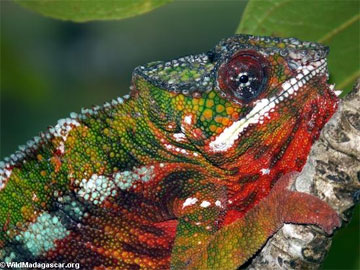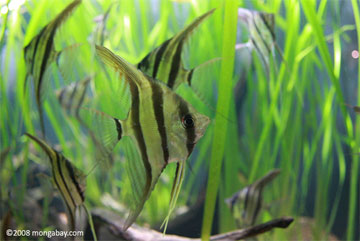Poor regulation of the international wildlife trade has increased the vulnerability of the U.S. to outbreaks of disease and alien invasive species, report researchers writing in Science.
Analyzing Law Enforcement Management Information System (LEMIS) data gathered by the U.S. Fish and Wildlife Service from 2000 through 2006, Katherine Smith of Brown University and colleagues found that of the more than 1.5 billion live wildlife animals legally imported to the United States during the period, only 14 percent were classified to the level of species despite federal mandates for such labeling. The lack of accurate reporting makes it impossible to “accurately assess the diversity of wildlife imported or the risk they pose as invasive species or hosts of harmful pathogens,” they write.
 Wild panther chameleon in Madagascar. Reptiles account for nearly 10% of legal shipments according to the new study. The illegal trade in wild reptiles is also substantial. |
“If we don’t know what animals are coming in, how do we know which are going to become invasive species or carry diseases that could affect livestock, wildlife or ourselves?” asked Peter Daszak, president of Wildlife Trust and a co-author on the paper.
“The threat to public health is real. The majority of emerging diseases come from wildlife,” added Smith, assistant research professor in the Department of Ecology and Evolutionary Biology at Brown University and lead author on the paper. “Most of these imported animals originate in Southeast Asia — a region shown to be a hotspot for these emerging diseases.”
The author cite the 2003 outbreak of Monkey Pox as an example of the health threat posed by wildlife imports. The virus — contracted from pet prairie dogs infected with monkeypox by African rodents imported for the pet trade — resulted in 72 human cases, but no deaths.
 Altum angelfish. Fish account for 90% of the live animal specimens and 26% of the shipments imported into the United States. Live corals for aquariums accounted for the largest share of shipments at 33.5%, according to the study. Altum angelfish. Fish account for 90% of the live animal specimens and 26% of the shipments imported into the United States. Live corals for aquariums accounted for the largest share of shipments at 33.5%, according to the study. |
The researchers found that 92 percent of imports were designated for commercial purposes, the majority of which were for the pet trade. Almost 80 percent of shipments contained animals from wild populations, “the majority of which have no mandatory testing for pathogens before or after shipment,” they note.
“That’s equivalent to every single person in the U.S. owning at least five pets,” said Smith.
The authors call for stronger regulation to improve monitoring of the live wildlife trade. They note that Congress is currently deliberating the Nonnative Wildlife Invasion Prevention Act (HR 669), which would tighten regulations on wildlife imports but say that the proposed legislation doesn’t go far enough to control what they term “pathogen pollution.”

A snake with eyes bigger than its stomach. Michael Barron of the National Park Service took this picture of a carcass of an alligator as it protrudes out from the body of a dead Burmese python in Everglades National Park, Florida. The Burmese python is an invasive species — 144,000 were imported to the U.S. between 2000 and 2005 for the pet trade. |
“We believe measures should include third-party screening of selected species for high-priority diseases before importation—a measure not covered by H.R. 669. Screening would be improved by the development and/or validation of testing tools,” the write.
The authors further urge education programs to make individuals, importers, veterinarians and the pet industry aware of the “dangers of diseases transmitted from wildlife to humans and domesticated animals.” They also call for captive-breeding initiatives to reduce pressure on wild populations and reduce the risk of disease introduction.
Katherine F. Smith et al. Reducing the Risks of the Wildlife Trade. 1 MAY 2009 VOL 324 SCIENCE Supporting Online Material














